Termites are among the most destructive pests that can invade your home, capable of causing thousands of dollars in structural damage. While the thought of a termite infestation can be overwhelming, these slow-eating insects (the average colony consumes only a pound of wood in 5 years) give you time to take action. This comprehensive guide will walk you through proven methods to eliminate termites and protect your home from future infestations.
Quick Picks: How to Get Rid of Termites
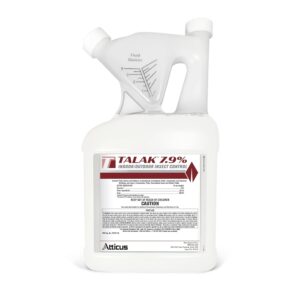
Professional Grade
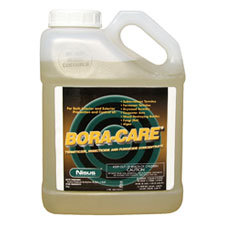
Prevention Expert

Natural Solution
- Identifying Termite Infestations
- Types of Termites and Their Behavior
- Professional vs. DIY Treatment Options
- Chemical Treatment Methods
- Natural and Organic Treatment Methods
- Wood Treatment and Prevention
- Structural Modifications for Prevention
- Monitoring and Maintenance
- Signs of Treatment Success
- When to Retreat
- Emergency Situations
- Integration with Pest Management
- Long-Term Property Protection
- Advanced Treatment Technologies
- Frequently Asked Questions
- Conclusion
Identifying Termite Infestations
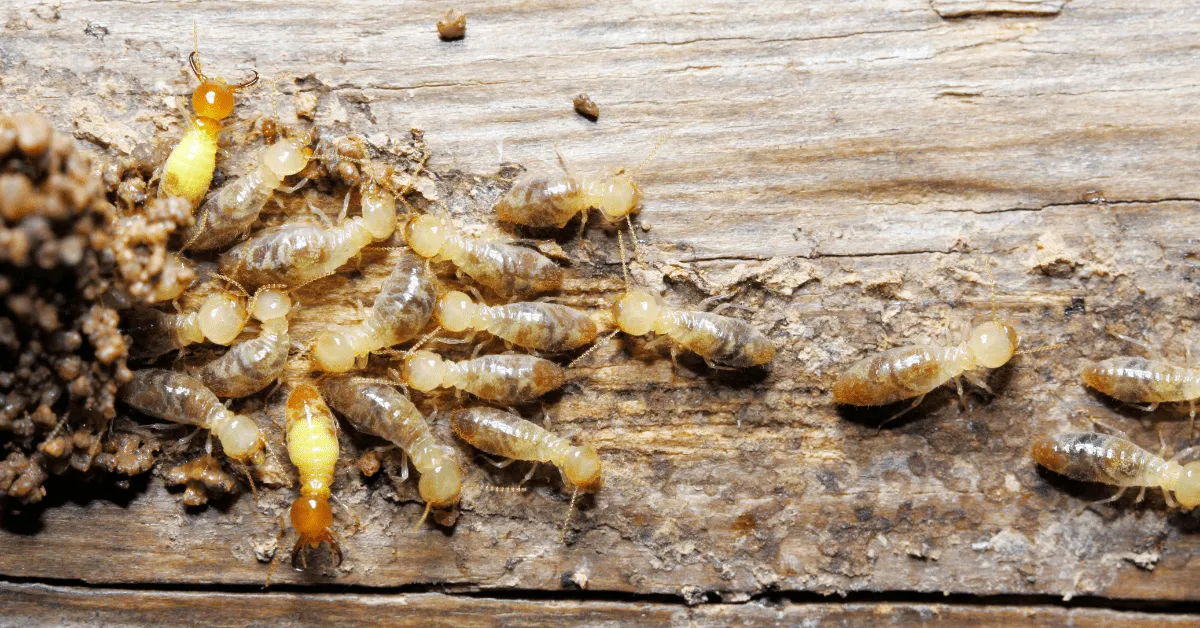
Before you can effectively learn how to get rid of termites, you need to confirm their presence and identify the type of infestation. Proper identification determines the most effective treatment approach for your specific situation.
Signs of Termite Activity
Termites leave behind several telltale signs of their presence. During your inspection, look for these key indicators:
Visual Evidence
Discarded wings near windows, doors, or light sources indicate recent swarming activity. You may also spot live termites, which appear as small, pale insects with straight antennae.
Structural Damage
Tap wooden surfaces with a screwdriver handle. Hollow sounds or wood that easily gives way when probed may indicate internal damage from feeding termites.
Mud Tubes
Pencil-thick mud tunnels along foundation walls, crawl spaces, or wooden structures indicate subterranean termite activity.
Frass Pellets
Small, wood-colored pellets near wooden structures are drywood termite droppings, indicating an active infestation in the area.
Areas to Inspect

Focus your inspection efforts on areas where termites are most likely to establish colonies:
- Foundation and Basement Areas: Check along foundation walls, support beams, and any wood-to-soil contact points for mud tubes or damage.
- Crawl Spaces: Examine floor joists, subfloor areas, and any exposed wooden structures for signs of feeding or mud tube construction.
- Moisture-Prone Areas: Inspect bathrooms, kitchens, laundry rooms, and areas around plumbing for increased termite activity due to higher moisture levels.
- Wooden Structures: Check decks, porches, wooden fences, and any outdoor wooden structures that contact the ground.
- Attic Spaces: Look for drywood termite evidence in roof structures, especially in warmer climates where these species are common.
Types of Termites and Their Behavior
Understanding the specific type of termite infesting your property is crucial for selecting the most effective elimination strategy. The two main types affecting homes in the United States have distinctly different behaviors and require different treatment approaches.
Subterranean Termites

Representing approximately 90% of termite infestations in the United States, subterranean termites are the most destructive and widespread species. These insects live primarily in soil and require constant moisture to survive.
Behavior and Habitat: Subterranean termites build extensive underground colonies that can house hundreds of thousands of individuals. They construct mud tubes to travel between their soil-based nests and food sources, protecting themselves from dry air and predators. These termites can travel up to 150 feet from their colony to find food.
Damage Patterns: These termites typically cause more extensive structural damage than drywood species due to their larger colony sizes. They eat wood from the inside out, often leaving a thin veneer of surface wood that can make damage difficult to detect until it becomes severe.
Drywood Termites
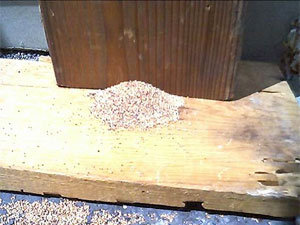
Drywood termites account for approximately 10% of termite infestations but can cause significant localized damage. Unlike their subterranean cousins, these insects live entirely within the wood they consume and do not require soil contact.
Behavior and Habitat: Drywood termites establish colonies directly in wooden structures, furniture, and other cellulose-containing materials. They obtain moisture from the wood they consume and from metabolic processes, allowing them to survive in relatively dry conditions.
Damage Patterns: These termites create large chambers connected by tunnels within wooden structures. They periodically push their fecal pellets (frass) out of small holes, creating telltale piles of wood-colored droppings near infested areas.
Geographic Distribution: Drywood termites are primarily found in coastal areas and southern states, including California, Florida, Texas, and Louisiana, where the climate supports their survival.
Termite Damage Examples
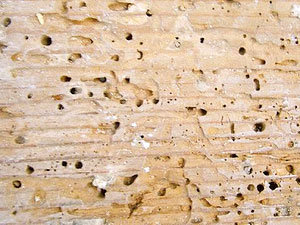
Severe structural damage from long-term subterranean termite feeding
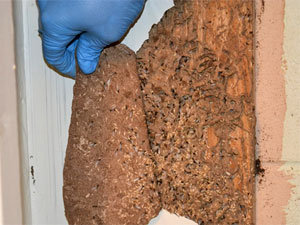
Termite tunnels visible in damaged drywall containing cellulose

Characteristic mud tubes indicating active subterranean termite activity
Professional vs. DIY Treatment Options
Deciding between professional treatment and do-it-yourself methods depends on several factors, including the extent of infestation, termite species, and your comfort level with pesticide application.
When to Call Professionals
Professional treatment is recommended in these situations:
- Extensive structural damage: If you discover significant wood damage or multiple infestation sites
- Subterranean termite colonies: Large underground colonies typically require professional-grade treatment systems
- Recurring infestations: If previous DIY treatments have failed to eliminate the problem
- Valuable property protection: For high-value homes where the cost of potential damage exceeds treatment costs
- Warranty protection: Many professional treatments include multi-year warranties and regular inspections
Professional Treatment Benefits
- Access to professional-grade termiticides not available to consumers
- Specialized equipment for soil injection and wood treatment
- Comprehensive property assessment and treatment planning
- Ongoing monitoring and maintenance programs
- Treatment warranties and damage guarantees
DIY Treatment Considerations
DIY methods can be effective for localized infestations and prevention, particularly with drywood termites. Success depends on proper identification, product selection, and thorough application.
Chemical Treatment Methods
Chemical termiticides remain the most effective option for eliminating established termite colonies. Modern formulations are designed to be more environmentally friendly while maintaining high efficacy against target pests.
Atticus Talak 7.9% Bifenthrin Concentrate
Amazon's ChoiceHow Does It Work
How to Use
- Dilute according to label instructions - typically 1-2 fl oz per gallon of water for general pest control
- For termite treatment, apply as a soil treatment around foundation perimeter
- Can be applied using pump sprayers, hose-end sprayers, or professional application equipment
- Safe for indoor and outdoor use on various surfaces including foundations, crawl spaces, and structural wood
- Allow treated areas to dry completely before allowing people and pets to re-enter
- Contains 7.9% bifenthrin - same active ingredient used by professionals
- Controls termites plus 75+ other indoor and outdoor pests
- Water-based formula dries clear with no odor or residue
- Long-lasting protection for up to 3 months
- Easy-pour bottle design reduces waste and spills
- Safe for use around plants - will not cause phytotoxicity
- Kills on contact while providing residual control
- Not available for sale in Connecticut, New York, or Vermont
- Requires proper dilution and mixing before application
- Professional-grade concentration requires careful handling
- May require multiple applications for severe infestations
- Higher upfront cost compared to ready-to-use formulations
Soil Treatment Applications
Soil treatment creates a chemical barrier that prevents subterranean termites from accessing wooden structures. This method is most effective for new infestations and long-term prevention.
Application Process: Professional soil treatments involve creating a continuous chemical barrier in the soil around and under the structure. This typically requires trenching around the foundation perimeter and injecting termiticide at specified intervals and depths.
Natural and Organic Treatment Methods
For homeowners preferring non-chemical approaches, several natural methods can effectively control termite populations, particularly for localized infestations and prevention.
Beneficial Nematodes
Natural SolutionHow Does It Work
How to Use
- Store nematodes in refrigerator until ready to use
- Mix with water according to package instructions
- Apply during cool parts of day (early morning or evening) to avoid UV damage
- Spray onto soil and affected areas using garden sprayer
- Keep treated areas moist for several days to ensure nematode survival
- Reapply every 2-3 months for ongoing protection
- Completely natural and non-toxic to humans and pets
- Targets termites specifically without harming beneficial insects
- Can be used safely around children and sensitive areas
- Provides ongoing control as nematodes reproduce
- No chemical residues or environmental concerns
- Requires proper storage and handling to maintain viability
- UV light and extreme temperatures can kill nematodes
- May take longer to show results compared to chemical treatments
- Effectiveness depends on proper application and environmental conditions
- Higher initial cost per treatment compared to some alternatives
Boric Acid Treatment
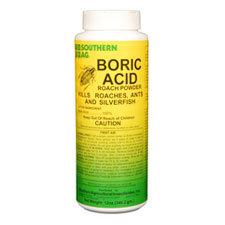
Boric acid is one of the most effective natural insecticides for termite control. This naturally occurring compound disrupts termite nervous systems and causes dehydration, leading to colony elimination.
Application Methods:
- Direct wood treatment: Spray or brush boric acid solution onto infested wood surfaces
- Bait stations: Create bait stations using boric acid mixed with attractive materials
- Dust application: Apply boric acid powder into termite galleries and entry points
Essential Oil Treatments

Certain essential oils have proven effective against termites, particularly for prevention and treatment of localized infestations.
Effective Essential Oils:
- Clove bud oil: Contains eugenol, which is toxic to termites on contact
- Vetiver oil: Acts as a natural repellent, preventing termite colonization
- Orange oil: Contains d-limonene, which dissolves termite exoskeletons
Physical Control Methods
Several non-chemical methods can effectively eliminate termites, particularly drywood species in localized infestations.
Heat Treatment: Expose infested wood to temperatures of 120°F or higher for 35 minutes to kill all termite life stages. This can be accomplished through direct sunlight exposure or professional heat treatment equipment.
Cold Treatment: Freezing infested wood for 2-3 days can eliminate termite colonies, though this method is limited to portable items.
Electrocution: Portable electric devices can eliminate termites in wood through controlled electrical current, though professional equipment is typically required for effective results.
Wood Treatment and Prevention
Protecting wooden structures from termite damage is often more cost-effective than treating active infestations. Several treatment options can make wood unattractive or toxic to termites.
Bora-Care Wood Treatment
Prevention ExpertHow Does It Work
How to Use
- Apply to bare wood surfaces using brush, roller, or spray equipment
- Ensure complete coverage of all exposed wood surfaces
- Allow adequate drying time before painting or sealing treated wood
- Apply before construction for new wood or to exposed wood during renovation
- Use proper ventilation during application in enclosed spaces
- Provides lifetime protection when properly applied to exposed wood
- Low toxicity to humans and pets compared to conventional pesticides
- Prevents multiple wood-destroying pests, not just termites
- Can be applied to both new construction and existing structures
- Will not stain or discolor wood surfaces
- Must be applied to bare wood before painting or sealing
- Cannot penetrate through paint, stain, or sealed surfaces
- Initial treatment cost is higher than some alternatives
- Requires professional application for optimal results
- Not effective against existing infestations without additional treatment
Pressure-Treated Lumber
For new construction or replacement projects, pressure-treated lumber provides built-in termite resistance. Modern pressure treatments use copper-based compounds that are toxic to termites while being safer for humans and the environment than older arsenic-based treatments.
Natural Wood Alternatives
Consider naturally termite-resistant materials for construction and landscaping projects:
- Cedar: Contains natural oils that repel termites
- Redwood: Natural tannins provide termite resistance
- Cypress: High oil content deters termite feeding
- Composite materials: Synthetic alternatives eliminate cellulose content that attracts termites
Structural Modifications for Prevention

Making your home less attractive to termites through structural modifications provides long-term protection and reduces the likelihood of future infestations.
Moisture Control
Eliminating excess moisture is one of the most effective prevention strategies, as termites require water for survival and are attracted to damp conditions.
- Foundation Drainage: Install proper drainage around your home’s foundation to direct water away from structural elements. Ensure gutters and downspouts function properly and extend at least 4 feet from the foundation.
- Ventilation Improvements: Increase ventilation in crawl spaces, basements, and attics to reduce humidity levels. Install exhaust fans in bathrooms and kitchens to manage moisture from daily activities.
- Plumbing Maintenance: Repair leaky pipes, faucets, and HVAC systems promptly. Check for hidden leaks behind walls and under floors that could create ideal termite conditions.
- Landscaping Drainage: Grade soil away from your home’s foundation and avoid over-watering plants near the structure. Consider installing French drains in areas prone to water accumulation.
Physical Barriers
Installing physical barriers can prevent termite access to your home’s structure without relying on chemical treatments.
Steel Mesh Installation: Install 6-mesh or finer steel mesh around foundation vents, pipe penetrations, and other potential entry points. The mesh should extend at least 4 inches in all directions from openings.
Sand Barriers: For new construction, a properly installed sand barrier around the foundation can impede subterranean termite movement. The sand must be of specific particle size (10-16 mesh) to be effective.
Concrete Caps: Install concrete caps on masonry walls and seal all cracks and joints to eliminate hidden entry points that termites exploit.
Wood-to-Soil Contact Elimination
Removing direct contact between wooden structures and soil eliminates easy access routes for subterranean termites.
Foundation Clearance
Maintain at least 6 inches of clearance between soil and any wooden structural elements. This includes siding, deck supports, and porch structures.
Landscaping Separation
Keep mulch, plants, and decorative wood elements at least 12 inches away from your home’s foundation to reduce moisture and eliminate termite highways.
Storage Practices
Store firewood, lumber, and other cellulose materials away from your home and off the ground. Use metal or concrete blocks to elevate stored materials.
Entry Point Sealing
Seal all cracks and crevices in your foundation, walls, and around utility penetrations with appropriate caulk or concrete repair materials.
Monitoring and Maintenance
Ongoing monitoring is essential for early detection of new termite activity and ensuring the continued effectiveness of treatment and prevention measures.
Regular Inspection Schedule
Establish a systematic inspection routine to catch termite problems before they become severe:
Monthly Checks: Inspect easily accessible areas like basements, crawl spaces, and around the foundation perimeter for new mud tubes, damaged wood, or swarmers.
Quarterly Inspections: Conduct more thorough examinations including attic spaces, storage areas, and outdoor wooden structures. Check moisture levels and ventilation systems.
Annual Professional Inspections: Have a licensed pest control professional perform comprehensive property inspections, even if no problems are apparent. Many companies include these in maintenance contracts.
Monitoring Stations
Install termite monitoring stations around your property perimeter to detect termite activity before it reaches your home’s structure.
Station Placement: Install stations every 10-15 feet around your home’s perimeter, focusing on areas with previous activity or conducive conditions. Mark station locations for easy monthly checking.
Bait Integration: Modern monitoring systems can be converted to active bait stations when termite activity is detected, providing targeted elimination of discovered colonies.
Effective Monitoring Tips
- Keep detailed records of inspection findings with dates and photos
- Monitor stations during spring and fall when termite activity peaks
- Check stations more frequently during warm, humid weather
- Learn to distinguish termites from ants to avoid false alarms
- Maintain monitoring stations by replacing wet or moldy wood regularly
Signs of Treatment Success
Determining when termite treatment has been successful requires understanding what to look for and how long results typically take to appear.
Immediate Indicators
Some signs of treatment effectiveness appear relatively quickly after application:
- Reduced live termite sightings: Fewer live termites in treated areas within 1-2 weeks
- Discontinued mud tube construction: No new mud tubes appearing after treatment
- Elimination of swarmers: No reproductive termites emerging from treated structures
Long-term Success Indicators
Complete colony elimination may take several months, with these indicators of long-term success:
- No new damage: Absence of fresh wood damage or feeding signs after 3-6 months
- Structural stability: Previously damaged wood shows no further deterioration
- Monitoring station activity: No termite activity detected in monitoring stations around the property
When to Retreat
Sometimes initial treatments may not completely eliminate termite colonies, requiring additional applications or alternative treatment approaches.
Retreatment Indicators
Consider retreatment when you observe these signs:
- Continued live activity: Live termites still present 6-8 weeks after treatment
- New damage progression: Fresh wood damage appearing in treated areas
- Mud tube reconstruction: New mud tubes built over or around previously treated areas
- Monitoring station activity: New termite activity detected in perimeter monitoring stations
Alternative Treatment Approaches
If initial treatment methods prove ineffective, consider these alternative strategies:
Combination Treatments: Use multiple treatment methods simultaneously, such as combining bait stations with soil treatment for comprehensive colony elimination.
Treatment Method Changes: Switch from liquid termiticides to bait systems, or vice versa, as different colonies may respond better to different approaches.
Professional Consultation: Consult with pest control professionals who can assess why initial treatments failed and recommend more targeted approaches.
Emergency Situations
Certain termite situations require immediate action to prevent catastrophic structural damage or when infestations threaten the safety of building occupants.
When to Take Immediate Action
These situations require urgent professional intervention:
- Structural compromise: Visible sagging floors, doors that won’t close, or obvious structural weakening
- Massive swarms indoors: Large numbers of winged termites emerging inside your home
- Extensive mud tube networks: Numerous large mud tubes covering foundation walls or basement areas
- Multiple species infestation: Evidence of both subterranean and drywood termites simultaneously
Temporary Protection Measures
While waiting for professional treatment, implement these temporary measures:
- Remove food sources: Clear away stored wood, cardboard, and paper near infested areas
- Reduce moisture: Run dehumidifiers and improve ventilation to make conditions less favorable
- Document damage: Take photos and notes for insurance claims and professional assessment
- Isolate infested items: Remove infested furniture or wood items from the main structure if possible
Integration with Pest Management
Effective termite control works best as part of a comprehensive pest management strategy that addresses multiple pest threats simultaneously.
Coordinated Treatment Approaches
Many effective pest management strategies can address termites alongside other common household pests:
- Ant Control Integration: Since ants and termites often compete for similar resources, eliminating ant colonies can reduce overall pest pressure and make termite monitoring more effective.
- Moisture Management: Controlling humidity and water sources benefits multiple pest control efforts, reducing problems with termites, cockroaches, and other moisture-loving pests.
- Structural Maintenance: Sealing entry points and maintaining building integrity prevents access for termites, ants, rodents, and other structural pests.
- Landscaping Coordination: Proper plant selection and maintenance reduces habitat for termites while controlling other garden pests that might damage your property.
Professional Service Coordination
Many pest control companies offer comprehensive services that address multiple pest concerns in a coordinated manner:
Integrated Treatment Plans: Professional services can develop treatment schedules that address termites during their active seasons while managing other pests year-round.
Monitoring System Integration: Modern pest monitoring systems can detect multiple pest types, providing early warning for various threats to your property.
Long-Term Property Protection
Developing a long-term termite protection strategy ensures ongoing property protection and helps maintain property values over time.
Maintenance Schedule Development
Create a systematic approach to ongoing termite prevention and monitoring:
Monthly Tasks
Check monitoring stations, inspect visible wood structures, and verify moisture control systems are functioning properly.
Quarterly Reviews
Conduct detailed property inspections, review treatment effectiveness, and update monitoring records.
Annual Assessments
Professional inspections, treatment plan updates, and evaluation of new prevention technologies.
Preventive Maintenance
Regular structural maintenance, moisture control updates, and landscaping modifications as needed.
Property Value Protection
Effective termite management protects and can even enhance property values:
Documentation Benefits: Maintain detailed records of all treatments, inspections, and preventive measures. This documentation can be valuable for property sales and insurance claims.
Warranty Maintenance: Keep professional treatment warranties current, as these provide valuable protection and can be transferred to new property owners.
Proactive Improvements: Implement structural improvements that both prevent termites and enhance property appeal, such as improved drainage and moisture control systems.
Advanced Treatment Technologies
The termite control industry continues to develop new technologies that improve treatment effectiveness while reducing environmental impact.
Monitoring Technology Advances
Modern monitoring systems incorporate technology for improved detection and management:
- Remote monitoring: Systems that alert homeowners and professionals to termite activity via smartphone apps
- Acoustic detection: Devices that detect termite feeding sounds within wooden structures
- Thermal imaging: Professional tools that identify termite activity through temperature variations
- Moisture sensors: Integrated systems that monitor conditions conducive to termite activity
Treatment Innovation
New treatment approaches continue to improve effectiveness and safety:
Targeted Delivery Systems: New formulations that improve active ingredient delivery to termite colonies while reducing environmental exposure.
Biological Control Advances: Enhanced beneficial organism applications and new natural control agents that specifically target termite biology.
Smart Bait Systems: Monitoring stations that automatically deploy treatment when termite activity is detected.
Frequently Asked Questions
How long does it take to eliminate a termite colony?
Complete termite colony elimination typically takes 3-12 months depending on the colony size, treatment method used, and environmental conditions. Bait systems may take longer to show results but often provide more complete colony elimination than liquid treatments.
You should start seeing reduced termite activity within 2-4 weeks of treatment, but patience is important as rushing to retreat too quickly can actually reduce treatment effectiveness.
Can I treat termites myself or do I need a professional?
DIY treatment can be effective for localized drywood termite infestations using methods like orange oil, boric acid, or beneficial nematodes. However, extensive subterranean termite colonies typically require professional treatment due to their size and the specialized equipment needed for effective soil treatment.
Consider professional treatment if you discover extensive damage, multiple infestation sites, or if previous DIY attempts have been unsuccessful.
What’s the difference between subterranean and drywood termites?
Subterranean termites live in soil and build mud tubes to access wooden structures. They require constant moisture and typically cause more extensive damage due to larger colony sizes. Drywood termites live entirely within the wood they consume and don’t require soil contact.
Subterranean termites are found throughout most of the United States, while drywood termites are primarily in coastal and southern regions. Treatment approaches differ significantly between the two types.
How much does professional termite treatment cost?
Professional termite treatment costs vary widely based on home size, infestation extent, and treatment method. Liquid soil treatments typically range from $1,200-3,000, while bait station systems cost $800-2,500 for installation plus annual monitoring fees.
While the upfront cost may seem significant, it’s typically much less than the $3,000-8,000 average cost of repairing termite damage.
Are termite treatments safe for pets and children?
Modern termite treatments are designed to be safe when applied according to label instructions. Professional-grade treatments are applied in targeted areas away from living spaces, and most products break down naturally over time.
Natural options like beneficial nematodes and boric acid treatments have very low toxicity to mammals. Always follow safety guidelines and keep children and pets away from treated areas until products have dried completely.
How can I tell if termite treatment is working?
Signs of successful treatment include reduced live termite sightings within 1-2 weeks, no new mud tube construction, and absence of swarming activity. Complete success may take several months and is indicated by no new wood damage and negative monitoring station results.
If you continue seeing live termites or new damage after 6-8 weeks, consult with your treatment provider about retreatment options.
What attracts termites to homes?
Termites are attracted to cellulose (found in wood and paper), moisture, and warm temperatures. Common attractants include wood-to-soil contact, leaky pipes, poor drainage, mulch against foundations, and stored wood near the home.
Eliminating these attractants through proper moisture control, structural modifications, and good housekeeping practices significantly reduces your risk of infestation.
Can termites come back after treatment?
Termites can return if the original colony wasn’t completely eliminated or if new colonies establish in the area. This is why ongoing monitoring and maintenance are crucial components of effective termite management.
Professional treatments often include warranties and annual inspections to catch any new activity early. Maintaining prevention measures like moisture control and monitoring stations helps prevent reinfestations.
Should I be concerned about one or two termites?
Finding even a few termites indicates a larger colony is nearby, as worker termites venture out from established nests to find food sources. A single termite colony can contain thousands to hundreds of thousands of individuals.
Take any termite discovery seriously and conduct a thorough inspection of your property. Early detection and treatment are much more effective and less expensive than dealing with established infestations.
What time of year are termites most active?
Termite activity varies by region and species. In most areas, activity peaks during spring and early summer when temperatures warm and humidity increases. Swarming typically occurs in spring when reproductive termites leave colonies to establish new ones.
However, in heated buildings and warmer climates, termites can remain active year-round, making ongoing monitoring important regardless of season.
Conclusion
Successfully eliminating termites requires a comprehensive approach that combines proper identification, appropriate treatment selection, and ongoing prevention measures. Whether you choose DIY methods for localized infestations or professional treatment for extensive colonies, the key to success lies in taking action promptly and maintaining vigilance over time.
Remember that termite control is not a one-time event but an ongoing process of monitoring, prevention, and maintenance. By implementing the strategies outlined in this guide and staying proactive about property protection, you can effectively eliminate current infestations and prevent future termite problems.
For ongoing termite management, establish regular monitoring routines, maintain proper moisture control, and keep detailed records of all treatments and inspections. With consistent effort and the right approach, you can protect your property from these destructive pests and maintain its structural integrity for years to come.

Bye, bye termites! Apply kerosene in a well ventilated area. Repeat the application 1 x daily for 3 days. Use a brush or syringe to get the product into the tiny holes of your piece of furniture. Caution: kerosene is flammable. i have only used it on furniture infested with termites with excellent results.
I find black like dots on myj floor and they get on my skin. What are those black like dots that I pick off of my floor through out the day???
Have found termites in our apartment wood kitchen cupboards and cabinets which were installed three years ago. For the last year we have been spraying the cabinets at least twice a month with Spectracide Terminate which we buy at Home Depot. They go away (we do not see wings or droppings) for two weeks, but then again they come back. We have wings on the kitchen counters and droppings again plus some wingless dead ones. Sometimes live wingless ones too. Anything you can suggest on what can we do outside of calling an exterminator to end this never ending saga. Is there a fogger that you would recommend? We close the apartment from June thru Sept when we leave Florida.
Thank you Cage. This is brilliant! I love Pine sol for general cleaning and floor mopping. You can get a twin pack of the gallon bottles of Pine Sol at Costco.
DISCLAIMER: I am not an extermination specialist, just a homebuilder/DIYer with tons of experience and a will to handle problems safely, efficiently, and cost-effectively. You’ll have to decide if this information is appropriate for your own personal situation. So here goes —
Full-strength Pine Sol kills termites in wood. I look for frass (looks like semi-glued-together dirty sawdust), scrape it loose, vac it up, and then use a bulb baster or needle syringe to squirt the Pine Sol full-strength into the cracks and soak the surrounding area. The wood really drinks it in (don’t use too much in particle board, or it will swell), and the strong smell is gone overnight as the Pine Sol is absorbed and dries. Use the Pine Sol sparingly and carefully around fine finishes (wipe it off immediately if it gets on shellac or varnishes, etc. but normal painted surfaces don’t appear to be a problem) and wash it off of your skin right away. I have applied Pine Sol at the top of stud walls to open framing members, repeatedly over the course of several days, really soaked it in; in a few days, the Pine Sol is evident at the base of the wall as it follows the wood grain/termite tunnel system all the way down. If you are living in the house, make sure to ventilate well, and treat just one big area at a time so that the smell doesn’t become too overpowering – let it dry over night, then treat another area, or the same area again if the infestation was really bad. Using Pine Sol, I have not seen any new evidence of termites (frass or actual termites) in the wood treated this way – going on about ten years now. In one particular case (a friend’s house – she was in tears and panicking when she found frass all along a thirty-foot long exterior wall section of her five-year-old house) we used almost 3 gallons of Pine Sol to soak/treat that wall over the course of several weeks (this allowed for full absorption, and prevented the insulation from getting laden with excess fluid)- cost was less than $50 – we drilled 1/2″ wide holes about 2″ down from the ceiling through the sheetrock and perhaps 1″ into the studs that we had located, then used a kitchen baster to apply the PineSol to the studs, letting it slowly soak down the length of the framing – a few days later we spackled the small holes and touched up the paint. “Generic” store brand Pine Sol type products seemed to work the same as the real deal.
By the way, I did a lot of research before treating the termite problem, since I wanted to be safe and don’t like wasting money (“tenting” by professional services isn’t always effective, and termites often return to fumigated areas within a year!). Pine Sol was once used to treat wood in dairy barns against rot and termites; the barnwood was prone to problems since it was frequently wet from daily washdown/cleaning. The Pine Sol fell out of use when petro-chemicals that have virtually no smell became available – those chemicals were (much later) found to be carcinogenic, so new chemicals were developed, again with problems, more new chemicals, ad nauseum.
Most dairy barns now have plastic walls, or sealed concrete, so current chemicals are generally bleach-related, just to kill bacteria – thus no need to control rot or termites. Keep in mind that Pine Sol is ALMOST natural, that is, it is derived from natural pine tars – but it is a chemical that is strong enough to kill insects and fungal rot, so use it carefully. Still, I think it is much safer than almost anything else (properly diluted with water, as directed on the label, it can be used as a “no-rinse” cleaner, even on countertops where food is prepared, and it is safe in the laundry and bathroom) – just limit direct exposure on your body with the full-strength Pine Sol.
Hi Guys, recently my external store was ‘attacked’ by Termites. I am testing by wrapping up all the paper boxes with plastic sheet cause some stuffs which were wrapped with plastic bags were left alone. However it would be safer to inspect and air the store by let the door ajar.
Good Luck
Dick Lim
i only seem then in the ceiling b.c they are reting to make tubes going down. i “see” no other areas not even tubes out side. )they once where there but not active anymore( what do i use to kill them in my ceiling or even better have them take it to the nest and kill them outright at there spot?
cant aford anyone still trying to pay off house tax..
I purchased a piece of furniture from Interior Shop. Furniture is from Peru I noticed something like wood grains on floor now reading others comments I have dry termites. Furniture is very large how do I treat it I have hollow places where they have eaten wood.
post about 2 to 3 ft.in the soil for roof support etc., been there about 2 years. what can i put around them to insure termits WIIL NOT want to stay for supper.. I live in heavy wooded area.
I found termites in my garage. After I scraped off the tubes on the cement walls I hosed them down. I checked the walls a few hours later and found a piece of cardboard that was sticking out and it was wet. There were termites crawling up and down a straight path to the wet cardboard! I sprayed them with rubbing alcohol I had In a spray bottle and they died with seconds. I was amazed. Tomorrow I will check and see if they are taking another walk. Hopefully, they are all going to this wet cardboard where they will have their last meal.
i found 2 flying termites today in my home. Never seen them before. ( i think they are termites but i do not know for sure ). im wondering how to figure out where the problem is? i read alot about checking window sills for frass, but i dont think i will find anything there. Gotta be a better way.
Bob,
Termites with wings have the following distinctive characteristics:
Antennae are straight, not elbowed
The waist is thick so there is no distinction between the body segments
Both pairs of wings are equal length
Ants with wings have these distinctive characteristics:
Antennae are elbowed as opposed to straight
The waist is pinched with a definite distinction between the body segments
The front pair of wings is longer than the rear pair of wings
These are the most notable differences that can be observed with the naked eye [5]. You can test your ability to tell flying ants and flying termites apart with this quiz by the University of California Statewide Integrated Pest Management Program.
This has been the most informative of all the articles I’ve read. I ordered the Boracare about a year ago to do remedial treating of active dry wood termites in my windowsill. Now that I’ve read about the bait stations and want to make them also, I’m not sure I should use the Boracare first. The termite frass is showing up everyday now, and I’ve gotta do something asap ! Please help !
Yes I remember reading somewhere, someone saying that termites are the only insects that can do major damage to your home, but this is not so, what about Carpenter ants?!!!!! Furthermore how can a person eradicate them !!!! Please help because not only am I having a problem with termites but now also Carpenter ants !!! Thank you
For your awesome articles!!!!!
Thank you for the help. I have a neighbor that just had to treat for termites, so I am trying to be sure to prevent them. I do not think there is an evidence of them around my house yet. At what point would you consider something like a termite bomb?
I never knew that clove bud oil is very good at killing termites. I even have a bottle at my house. I think I will give it a try and see if it is effective at killing all the termites that are eating through our front porch! I would rather get them now than later! Do you just apply some of the oil to the spot you think they are at?
Did it work? What did you do? I’m trying clove oil tomorrow. They comes out in droves when I spray Thieves cleaner in the cracks which actually has clove in it.
I have some furniture under attack. I am considering putting them in a contractor’s 55 gallon trash bag and putting some fog in there.
Which is the best fogger to use?
I read that most foggers don’t have a penetrating effect, so is this a waste of time?
I have just finished my cinema room and guess what I found two holes in my drywall. I couldn’t beleive it now I call some professionals to come and help me get rid of them lets pray they willbecause I invested a lot of money in the room.
I have a neighbor taking off his roof now there R termited flying all over the back yard . Am i at risk ? Is he responsible ?
Yes and no. If coming from the roof that may be drywood termites which must be treated and prevented differently than subterrainian . Google your concerns and search youtibe for thousands of videos to explain what to do yourself and save thousands.
My mother n law said she seen some bug flying out side the other day so Orkin. is coming today how an I continue to take care of my home after they find out where they are coming from what should I use to continue to spay every so often to keep them away?
Hello,
Thank you so much for this useful article because termites are destroying my room and I want them to get destroyed.
Thanks again.
I live in New Orleans, La and have for the past 2 years, had the worst termite infestation I would have imagined. Initially it started with a palm tree; once that was discovered and removed, my garage took a hard hit and then my home. I’ve had 2 different companies (none of the major companies) come out to treat the areas (balcony, master bath, garage and kitchen). Apparently this did nothing but anger the fricking termites because now they’re back (kitchen & garage, possibly wash room) with a vengeance. My home is 3000 sq ft and my garage almost 1000 sq ft. Because I believe it’s beyond my control, do you think I can get this under control by using a certified, reputable company? Help, this has cost me thousands, upon thousands of dollars and I’m at wits end.
My house had constructed 3 years old.. in construction time so many pests medecine were used in proper guidelines .but house is full y pest forming. how to rectified for long time for mentel pease.
2 weeks ago I started noticing termites were in my window sill! Now they are there EVERY DAY no matter how much I kill them and spray the window sill. It’s driving me crazy! I can’t find where they are coming in from. I NEED HELP PLEASE! I don’t want to turn to the exterminators quite yet.
How did you get rid of them?
Diflubenzuron is very effective against termites. Unfortunately it’s a regulated substance, however, there are some other products containing it that you can still find and buy, one of them being Dimilin. You can soak paper towels with 0.25% water solution or less and let it dry, do not use higher concentration, because crystals will be larger and termites can separate them from cellulose fiber. Cut off beer can tops, pack with the treated paper, then seal with a wood plug where you can drill holes for easier access of termites to the paper. Then bury the cans around your house upside down, so paper does not get soaked. Check in few months if the paper was consumed, if it was just replace with another batch of cans. Termites love eating paper, and will carry diflubenzuron to their nesting area. Larvae can’t molt in the presence of even traces of diflubenzuron.
The termite colony eventually will die out without replacement of workers. This is a good precautionary measure to prevent possible subterranean termite infestation, if termites already have found a way to your home you should use more aggressive methods of elimination
We just discovered that we have termites. A guy I know said to use oil to get rid of them. But my husband and I are leary to use oil because it can be flammable. What would you do?
I’ve read dozens of articles about termites and this site has the most cost effective and easy to understand explanations I’ve seen. Thank you!
I do have a question though; I had a swarm of termites in my bedroom and found termites in my ceiling trim and some in the attic. I dug a trench around my house and drilled holes in my slab every 8 inches and applied a well-known chemical to create a barrier. While I was digging I found where the subterranean termites were getting in under my bedroom. If I cut them off from their moisture source (poison), do I still need to cut out the sheetrock in my bedroom and make sure they’re gone? Also, how long do you think they’ll live after the moisture source has been eliminated?
Thanks so much!
The chemicals you used when trenching your house will eliminate the colocny and then create a barrier for any future attempts of entering your house and usually active for 3-5 years depending on the product. If it’s sub termites your dealing with in the house then the only reson to open up your walls is to repair damages if needed. Otherwise the chemicals applied basically attach to the termite and the termite spreads it to its colony eventually killing off the entire colony. If you read the label of your product it should tell you it will take 30 to 90 days depending on the colony size before they are eliminated. In the mean time it is common to continue to see their droppings and even swarms while the chemicals are slowly killing them all.
I live in an apartment and notice termites in my light globes in the bathroom should I be concerned maintenance as been aware
I want to know how much borax is required for termite eradicating for a hole made 8 mm diameter and 450 mm depth?
I have a rescue horse fat
I recently discovered what seems to be termites in my window sill after getting my home power washed. I can seem to find the source and I’m terrified because no matter how many I kill hours later there are like 30 more. I need help.
They are starting a new colony looking for a place to start a new hive.
Same here after Exterminator sprayed for bees. Now, they’re coming out of the cracks in the window sill. They come out in droves when I spray my Thieves cleaner in there. Tomorrow, I plan to try the clove spray as in the article and inspect the outside. This article was very informative. I even have vetiver which I use for concentration. I love how plants help with so much. Glad I educate other on natural living and using oils and other products. This will be fun to add.
Infact, the insects have brought down my room’s door and a friend told me to use black engine oil. Can somebody tell me how effective this is? because all this prescribed chemicals is not easy to get here in Nigeria
I would like to knw do tht oil wk too
I have found that oil penetrating wood deters termites. It, however does not seem be an effective measure to eliminate the problem. I have used a mixture of used oil, diesel fuel, and gasoline to kill the bugs. Gas has an immediate effect, but evaporates quickly, diesel lasts longer and it vapors seem to help, mixed with oil, for a hoped for deterrent. (I am in Peru, South America, do not have access to chemicals, and would not consider using this method in the States due to obvious risks and environmental concerns.) This works, but is not a permanent solution. The main infestation needs to be found and eliminated, it seems, regardless of the localized treatment. (My problem is infestation in nearby trees and mulch which I am not in a position to eliminate.)
Used motor oil does stop termites around concrete foundations,dig small trench close to footing pour oil in trench let oil sink in then give it a second pouring then back fill trench. I have good luck with this method doing every two years or as needed. Dave the handyman
yeah, that motor oil that you’re dumping into the group is doing wonders for the environment, especially the groundwater used by local wells.
it’s bad enough that industry is destroying the planet, but when bumblephuck joe starts doing it all it does is gets additional morons, like yourself, to follow the lead of the retarded pied piper.
Shawn, I’m sure you’re the leading expertI in oil pollution. But I think you are mistaken … this is a pest murdering website, NOT an environmental one.
Thank you for blabbering your uneducated opinion when no one asked for it.
Stay in your lane.
PS – Listen, we are all a little embarrassed for you. No one is buying into your pseudo-intellect. You may not be the brightest color in any coloring box or sharpest tool in the shed, but I’m sure some California people will find your opinions interesting.
I brought a crane from Haiti and found there are substance like salt/dust from it, and i found something like termites when i clean it up, what should i do?
Is the termites are favourite in that crane and would not travel around my house?
Each morning I’m discovering a salt like substance on the wood floors in our house near an entrance to our porch area WHICH IS TOTALLY ENCLOSED AND INSULATED. IS THIS FROM TERMITES?
Sounds like a fungus to me.If you have moist dark areas against brick or mortar or cement ( can’t recall seeing it in wood…). it can creep up the wals and leave the residue on the floor.
We also have been seeing salt like substances under our kitchen counter, which is not near any walls or entrances. We have granite counter tops sitting on a wood support and the salt like substance is under the wood support. We also noticed some cracks in the wood support right above the salt like substances. But we did not see any insects of any kind. Does it sound like termites, and what would be the best way to treat them in situations like this?
this guy exposed the real anserws about how to kill termites on your own.without throwing money away to companies like ORKIN OR TERMINEX.for example those companies use PREMISE 2 and PREMISE 75 and a few other brands you can buy yourself like i did on the internet.also you can use BORIC ACID its in borax soap and is also in boracare key word bora which is what is used to seep into wood to kill termites too.pest control companies use it too.DONT LET TERMITE COMPANIES TAKE YOU FOR A RIDE.
i just found out my sons dresser has drywood termites in it. i am kinda happy they arent subterranian termites because methods for the drywood termites seem a lot cheaper and safer. will put it out in the sunlight for about a week and have the house inspected asap! this article was extremely helpful! thanks!
Im going to try the cardboard trap first.